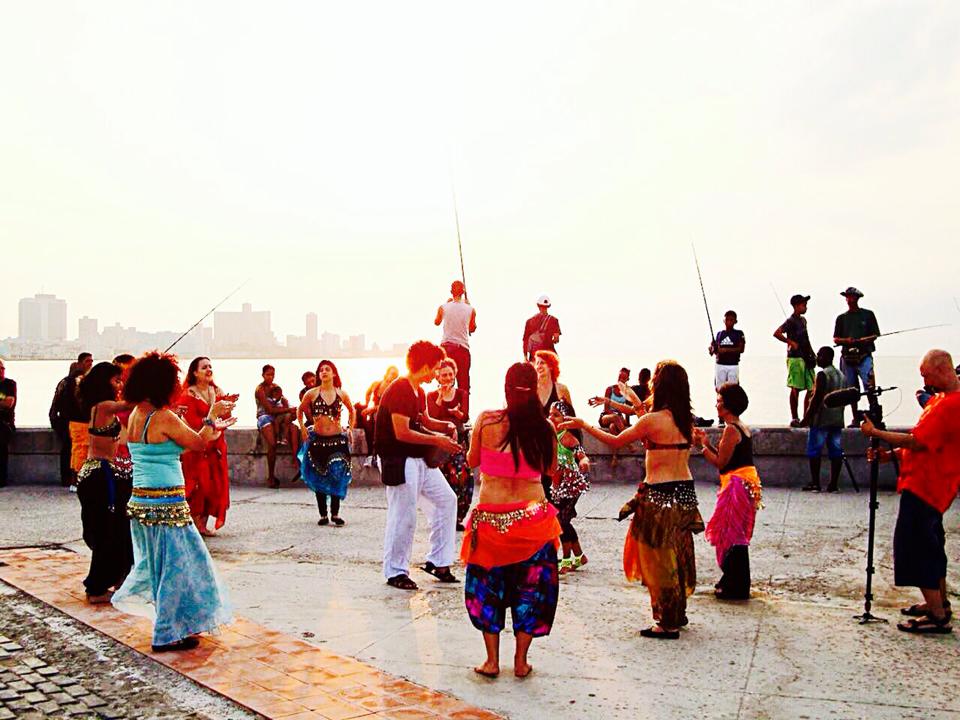
Changing culture one belly dance at a time
Above: “Havana Habibi.” Photo courtesy of Tiffany Madera.
“Havana Habibi,” which opens Thursday, June 9 at O Cinema Wynwood, is a documentary film about the fledgling feminist movement sparked by Tiffany Madera. It is also the centerpiece of a weeklong series of live performances, workshops and dialogues that immerses participants in Madera’s process as an artist.
In 2003, Madera journeyed to Cuba, where she founded Grupo Aisha Al-Hanan, Cuba’s first belly dance troupe and only belly dance school. From day one, the school transformed the lives of women and girls across the island. Through the discipline of belly dance, Madera discovered a new tool for personal and communal healing. She also found out that reconciliation and empowerment is possible, even within the context of a brutal regime.
Can you talk about the ways in which creating this project, the journey of making it, has helped heal or open old wounds for you and your family? My parents took my brother and I [sic] to Cuba in 1980. On that trip I experienced a lot of feelings I couldn’t articulate, but it changed me. Creating the project was a way to get back to those feelings and give them shape. My going back definitely opened up old wounds for my family here because it forced them to revisit spaces that were buried. Some sad, joyful, but all tinged with loss. The trip also created opportunities for healing. I’ve been able to meet and spend time with very close family members there–share love and stories–and create a new intimacy. This taught me duality. Being there connected me to sadness and loss that opened up old wounds I certainly didn’t expect. It forced me to revisit experiences that I had also buried. I had to be with some pain for a while, which wasn’t necessarily my plan. Belly dancing in Cuba, specifically, taught me to hold great sadness and joy together in the same space. It created a new womb of possibilities. I chose to reframe the ruptures of that experience with movement and love–and turned it into “Havana Habibi.”
What was the most important thing you learned while creating “Havana Habibi” and why? I learned that your destiny will show up in unexpected ways. I learned to focus on love and human connection and not all the noise and rhetoric around a topic. To be courageous in your beliefs. This project taught me to live in a very transparent way. The experience forced me to think about my nationality and identity in really complicated ways. What it meant to be American, Cuban, bilingual, bicultural, multicultural and hyphenated Caribbean. How I approach things–positionality, privilege–are like the waves in belly dancing. It taught me the fluidity and interconnectedness of things.

“Havana Habibi.” Photo courtesy of Tiffany Madera.
Living in Miami, one is aware of the conflict between and within Cuban families born in different generations. Younger and American-born Cubans are generally more open to stronger ties with their country. Do you think the divide between the generations will shrink? The divide is shrinking because some of the older generations are passing on and the newer generations are engaged in global culture and technology that makes the world smaller, closer, more open, more reachable. It’s harder for the younger generations to uphold the hardline positions of some of the older generations without engaging in sheer curiosity. The divide is an internal one. It’s how we engage with ideas, change and the choices we make toward understanding another world view. I think that seeing “Havana Habibi” makes that clear. So much can be created when you choose to move past old paradigms and create new ones.
What does reconciliation mean to you, and what role does the body, your body, play in telling this story? Reconciliation is the courage to create a new meaning and context around an idea, topic or event. The Cuban Revolution and the exile is a very painful story, but my reconciliation is to design a new story; one of movement and beauty to serve as an offering and counter-narrative.
Our bodies tell our story for sure. “Havana Habibi” chronicles a decade, so seeing my body change, my weight, what I experienced in my health and healing–it’s all there and very raw. Nothing sparkly or overproduced. One of the hardest parts of completing the film is seeing my body change so much over the years. In your fantasy you wish it were one way. Cuba teaches you to “see” differently, so my body is central to the story. It is a metaphor for change and vehicle for expression.
Belly dance (for you) is … Belly dance is a great friend. To me it is a path and a language that I love. I always say it’s an arc of self-discovery and identity, and I enjoy mentoring and coaching dancers along that path. It is a powerful and serious art form that deserves rigorous aesthetic interrogation. Belly dance is an umbrella term for a set of dance practices across various regions. For me now, it is a very personal expression of my deepest feelings. At first, it was a way to feel joy. It’s liberating. Makes me feel alive.
Sponsored by Knight Foundation and the Ware Foundation, “Havana Habibi” opens in Miami with a week of cultural activities and dialogues on gender and diasporic issues. The world premiere of the film will take place on June 9 at 6 p.m. at O Cinema Wynwood. For information on other events, visit the “Havana Habibi” Facebook page.
Recent Content
-
Artsarticle ·
-
Artsarticle ·
-
Artsarticle ·

